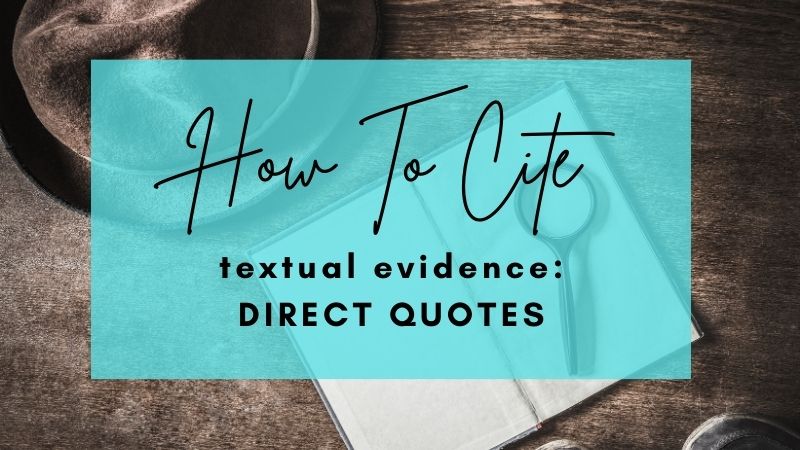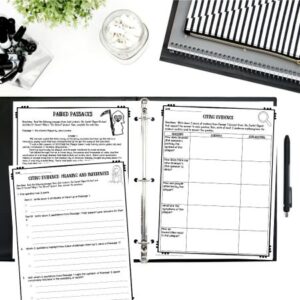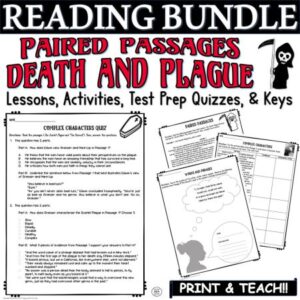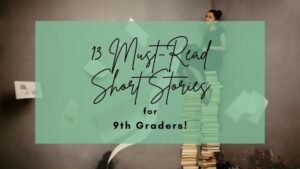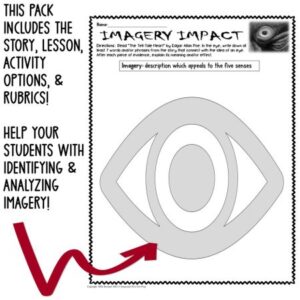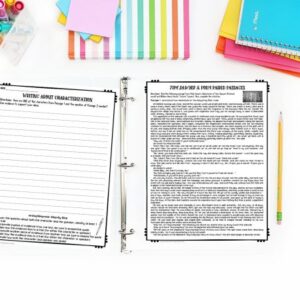One of the capstones of most reading comprehension standards is to HOW TO CITE TEXTUAL EVIDENCE! Every answer and/or claim needs support!
Unfortunately, most students struggle with how to cite textual evidence. They might know an answer because they understand the central idea or the main topic. Or they can make a basic inference. Many, however, don’t understand the need for citing textual evidence.
And really, this skill is key to pretty much any area of comprehension, analysis, and argument. Because we need to substantiate what we believe, we MUST teach our students how to cite textual evidence before pretty much any other standard!
Keep reading for ideas and activities that help you teach How To Cite Textual Evidence as Direct Quotes!
Need help with Reading Test Prep? Check out this FREE Pack of 3 Test Prep Activities to help students achieve success on standardized tests!

3 Characteristics of GOOD Evidence!
- Relevant: The evidence should directly support the answer to the question. If there is better evidence, then students need to learn to choose the BEST evidence possible. And the toughest part is the time it takes to find the best support. Patience is vital. Students need to practice rereading, skimming, and annotating, so they can locate the best and most relevant textual support.
- Specific: Sometimes, the evidence is vague. Vague is a no-go. The textual evidence might still be relevant and related, yet it might not be specific enough to connect to the student’s response. The more specific, the better. Think about our world today. People are lazy and/or uninformed, and instead of doing the hard work of researching, we are content to know generalities. As teachers, we can help our students become critical thinkers who know the facts and the actual research! Specificity is necessary when teaching our kids how to cite textual evidence!
- Essential: We only need to cite the evidence that is the most essential. I don’t know about you, but in college, I had a ton of professors who had a word or page limit. Because of this requirement, I was tempted to use a longer sentence or even a full paragraph in a paper. Let’s be real. We have all tried to extend our papers with evidence. We know this practice is not the best, so we need to teach our students to only use the detail, word, phrase, or sentence that is essential. When we cite, we may only need one, two, or ten words to prove our point. This use of evidence is good practice for the real world, where most people appreciate brevity. Substantiate your claim and move on!
What is Direct Textual Evidence?
Direct textual evidence includes words, phrases, sentences, or even paragraphs from a passage. Too often, we as teachers get either incredibly general details or we get super long paragraphs in quotation marks. Instead, we want concise evidence directly from the passage. Simply put, we need to teach our students how to cite textual evidence almost every time we want them to use evidence…
How to Cite Textual Evidence in 3 Steps:
- Reread the passage; go back to the text!
- Locate the specific word, phrase, or sentence that answers the question/supports your response.
- Cite the evidence by embedding a quote and referencing the source for a written response.
Look at the 2 examples below for how to provide and how to cite textual evidence. You will see that students are asked to locate the evidence and underline the phrases for the first activity. Then, for the second activity (like a quiz or state test), students have a choice of five phrases. They are all of varying lengths. The longest is not always correct, nor should it be assumed that it is more valid because it is long.
Here is an example of a citing evidence activity for an excerpt from Jack London’s The Scarlet Plague!
Directions: Write down 2 pieces of evidence from Passage 1 (excerpt from The Scarlet Plague) that support the answer to each question. Then, write at least 2 sentences explaining how the evidence could be used to answer the question.
| How does Granser (the speaker) portray the spread of the plague? | Ex. “Within twenty-four hours came the report of the first case in Chicago.”
Ex. “And on the same day, it was made public that London, the greatest city in the world, next to Chicago, had been secretly fighting the plague for two weeks and censoring the news despatches—that is, not permitting the word to go forth to the rest of the world that London had the plague.” |
Ex. Granser, the speaker, portrays the spread of the plague as quickly moving from major city to major city. He also describes how it affects many people in each city, yet no one wants to talk about it. |
Here is an example QUIZ QUESTION from this paired texts bundle.
Quiz Question
With which 2 quotations from Passage 1 might the speaker of Passage 2 agree concerning reactions to the possibility of death?
□“They were heroes.”
□“Anything you can’t see, ain’t, that’s what.”
□“Fighting things that ain’t with things that ain’t!”
□“As fast as they perished, others stepped forth and took their places.”
□“The coldness and the numbness crept up past her hips to her heart, and when it reached her heart she was dead.”
□“I ceased speaking and could only look at her, for the first fear of the plague was already on all of us and we knew that it had come.”
Here is the full paired passages reading test prep bundle, which requires students to learn how to cite textual evidence >>> Death and Plague Reading Test Prep BUNDLE
Want must-read short story ideas for this year? Click below!
How to CITE TEXTUAL EVIDENCE in various ways:
1. Using a word, phrase, or sentence from 1 text like a reading passage, poem, short story, etc.
Here is an example from an Imagery Activity Pack for “The Tell-Tale Heart” by Edgar Allan Poe for how to cite textual evidence in a VERY short response!
How does Poe use imagery to convey meaning in the text? Use evidence to support your ideas in 2-3 sentences!
Notice, we have 3 key elements. We embedded the following:
-
- The author’s full name is introduced at the beginning.
- The title of the text is mentioned.
- The word, phrase, or sentence is located in a sentence.
Want to read more about Edgar Allan Poe? Check out Edgar Allan Poe Love Poems: Teaching of Poetry!
2. Using a word, phrase, or sentence from 2 passages like for a paired passage short response or a comparison/contrast paper.
Here is an example from a Characterization Lesson for the Paired Passages: Tom Sawyer and Poem for how to cite textual evidence in a short paragraph!
Short Response: How are ONE of the characters from Passage 1 and the speaker of Passage 2 similar? Use evidence to support your ideas.
Jim from Passage 1 and the speaker of the poem for Passage 2 are similar in that they both want to take time to enjoy their lives, and they are also busy with various aspects of life. For example, Jim wants to take the time to interact with Tom; the narrator states, “He put down his pail, took the white alley, and bent over the toe with absorbing interest while the bandage was being unwound.” For Jim, viewing a sore toe was fascinating and worth his valuable time. Similarly, the speaker of the poem feels he has “No time” to view nature. Instead of being able to observe the beauty in nature, he is forced to “pass” by the “woods.” Likewise, both Jim and the speaker seem too busy and/or concerned with certain burdens. Jim claims, “I’s powerful ’fraid ole missis.” He is clearly afraid of the woman who has authority over him. In the same way, the poem’s speaker feels he has a “poor life” that is “full of care.” Because he is burdened by certain elements of life, most likely because of work, he is too busy to notice what really matters to him. Overall, both Jim and the speaker reveal the human struggle of wanting to play but needing to fulfill their responsibilities.
Notice: We have 3 key elements. When teaching how to cite textual evidence, embed the following:
-
- A reference to the speaker/author.
- The title of the text is mentioned; if it is just Passage 1 or Passage 2, that is fine as long as the directions allow for that.
- The word, phrase, or sentence is located in a sentence.
Check out the reading test prep resource below for help with how to cite textual evidence when writing a short response!
3. Using a word, phrase, or sentence from an online source for a research paper or rhetorical analysis.

-
- You will want to mention the author’s last name within the sentence or at the end of the sentence along with the title of the article.
- Ex. Bill Miller from the article “10 Steps to a Better You” claims that “everyone should exercise at least 60 minutes a day.”
- Ex. In the article “10 Steps to a Better You,” Bill Miller claims that “everyone should exercise at least 60 minutes a day.”
- Ex. The article “10 Steps to a Better You” outlines that “everyone should exercise at least 60 minutes a day” (Miller).
- You will want to mention the author’s last name within the sentence or at the end of the sentence along with the title of the article.
-
- If there is no author’s name mentioned, the title of the article should be included.
- Ex. The article “10 Steps to a Better You” outlines that “everyone should exercise at least 60 minutes a day.”
- Ex. Some assert that “everyone should exercise at least 60 minutes a day” (“10 Steps to a Better You”).
- If there is no author’s name mentioned, the title of the article should be included.
If you need help with how to cite textual evidence and analyze it for a rhetorical analysis essay, click HERE!
4 Sentence starters for EMBEDDING direct quotes:
- The author writes, “____________________.”
- Overall, Smith believes that “______________.”
- The article “5 Ways to Cite Evidence” relates the following: “_________________.”
- Some people argue that “________________” because________________________(your own ideas).
Why do we need to teach our students how to cite textual evidence?
More than anything, we want our students to be successful not just in our own classrooms but in the world beyond. They might choose to go to college. In any academic arena, professors will assign them tasks that will require students to cite textual evidence. Teaching them how to cite textual evidence repeatedly and offering our kiddos consistent practice will help in mastering this important skill!
Even if they don’t go to college or write another paper beyond high school, we want to empower our students to not merely accept a basic summary of someone else’s ideas. Instead, we want them to be critical thinkers and debaters who do research, find evidence, and cite their sources. This process will enable our students to become citizens who are critical and analytical; they will have something to say and actually know how to support their ideas with FACTS!
Let’s encourage our students not to rely on others to tell them what they need to know. Learning how to cite textual evidence is key! As a member of society, we individually need to think for ourselves and support all of our ideas with relevant, specific, and essential evidence at all times!
Need more activities for how to cite textual evidence! Check out my store!

